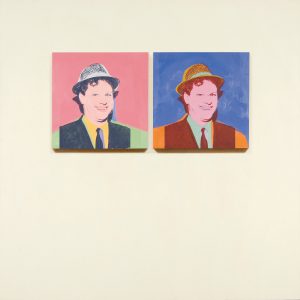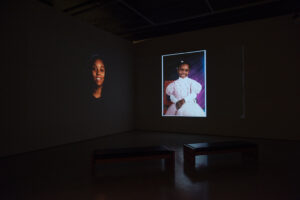The video production of Loved by Millions coincided with the development of Chris Cran’s exhibition of the same name at the AGW in 1989. Created by the artist’s long-time friend and colleague, painter John Will of Calgary, the video production playfully responds to the documentary tradition, featuring artist-subject, Chris Cran. John Will is a prominent artist known best for his works in painting, his critiques of popular culture, his humorous and ironic means of visual resolution. Will’s Loved by Millions traces the journey of Cran by air from his home city of Calgary to Detroit, and then by limousine to Windsor, to attend the opening of his 1989 solo show with his broker-agent and entourage in tow.
Together as feature screen character-subject and director-producer Will and Cran stage a quintessential parody on the canonized male artist whose career has soared to acclaim thanks to the machines of public relations and career management. Cran’s broker-agent claims to save the artist from unnecessary work in self-promotion that might take him away from his creative output. His role is to look after the details of the exhibition, the opening event, negotiations with the curator, the artist’s staged cover appearance in Vanity Fair magazine, and drives the messaging of arguments for the media’s consumption regarding the interpretation of Cran’s work. “Smart money buys smart art” and “believability is far more important that truth” he observes. In the CBC interview scene the agent primes both artist and reporter in language so clouded in obfuscation as to be unintelligible. So controlling is the agent during this interview that he even cuts Cran off entirely when he veers off script. Then, following the interview, the artist and his entourage arrive at the Gallery for opening night at the entrance to the AGW’s former home at 445 Riverside Drive West where Loved by Millions the exhibition was originally presented. They swerve into the looped driveway where Cran appears swooned by an adoring crowd. He makes his way to the exhibition gallery where a white-cube installation of his works awaits him. There he is seemingly amidst a large crowd but, as we are to learn from close scrutiny of the handshake video scene with private collector Peter Boyd (who has commissioned the artist to make him a work), the same handshakes are repeated over and over with a much smaller number of guests.
Loved by Millions plays on the media’s fascination with celebrity figures, staging Cran to have arrived at such a social place when in real space-time, this event marked one of the artist’s early major exhibitions and serious efforts to locate Cran’s practice into the public art gallery system. A graduate of the Alberta College of Art and Design in 1979, Cran’s work had only recently begun to garner the attention of critics outside Calgary, through his representation at Paul Kuhn Gallery where Cran had been showing in group-artist projects for the past three years. Cran had also shown solo in 1987 at the Southern Alberta Art Gallery in Lethbridge. At a time when the nation’s art world was anything but international, it remained extremely difficult to garner critical interest within Canada, much less beyond it. Will’s production plays on this paradigm by drumming up the commentary of five authorities, all of them happen to be Canadians: Tom Sherman of the Canada Council for the Arts, Duncan Cameron of the Glenbow Museum & Art Gallery, David Burnett of the Art Gallery of Ontario, Eric Cameron, fellow artist and colleague in Calgary, and finally Alf Bogusky, then Director of the AGW who was also clearly facilitating the production of Loved by Millions the video and exhibition.
Visually, in the tradition of the film documentary, Loved by Millions features Cran the subject and personality as autonomous famous artist. But his apparent screen dominance is subtly countered by Will in a scene in Detroit where the Cran limousine stops at a traffic light and Will, now actor too, cleans the front window and begs for money from the driver. The scene exposes Will’s ability to function in the double roles of director-actor and further counters his apparent disappearance into the production as subject and artist by also occupying the role of director-producer. This important scene evokes a spirit of collaborative jockeying that has long defined the Will-Cran friendship. In the film viewing experience, we have been trained to pay attention to the subject/actor-actress star of the moving image (Cran) and the Director-Producer (Will) and, in this respect, Loved by Millions does not surprise us in its perpetuation of this film reception strategy. Nevertheless, Will’s collaboration with Cran, and Cran’s with Will’s, only further dismantles the film’s subject and very theme of the autonomous creative genius. The production of Loved by Millions the video and Loved by Millions the exhibition were at once independent and interdependent projects. The two artists’ jockeying as male subjects in this collaborative process yielded a production whereby both offered valuable critiques on the social construction of fame in the late 20th century and society’s fascination with it.







